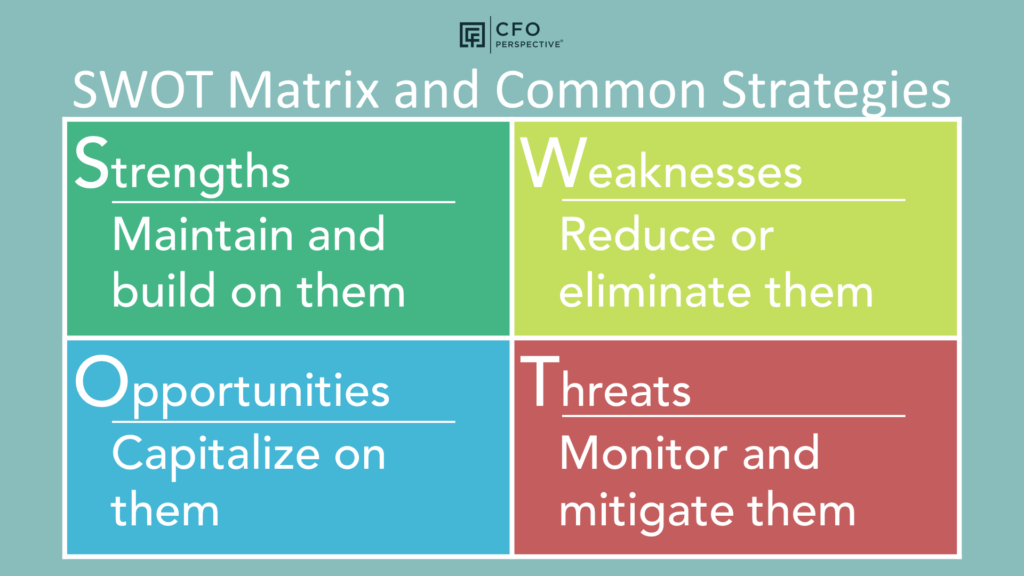You’ve probably heard of a SWOT analysis, but you may not be completely aware of how useful it can be for your company. SWOT analysis is a simple but powerful method to assess your company and competitive environment. This knowledge leads to superior strategic plans.
The simplicity of SWOT analysis can lure some to underestimate its effectiveness. SWOT’s simplicity and efficiency enhance its power.
What does SWOT mean?
SWOT stands for Strengths, Weaknesses, Opportunities, and Threats. It looks at each of these items to evaluate an organization, individual, or project. Strengths and weaknesses are internal. They are a result of the abilities of your people and other factors such as location and patents.
Opportunities and threats are external factors. Examples include new technologies, competitors, and environmental changes. These are things that you simply cannot control.
We will take a look at each of these items in more depth a little later.
What is the purpose of a SWOT analysis?
A SWOT analysis helps you understand your current place in the market and make future plans. Identifying your organizational strengths lets you know what aspects on which to focus. Knowing your weaknesses allows you to make improvement plans.
Recognizing opportunities is key for any organization’s growth. A SWOT analysis helps to make those known. It also helps recognize external factors that may threaten your bottom line or community standing.
By combining all this information, a SWOT analysis is an incredibly useful tool to provide the context for strategic planning. Your business strategy must fit with the realities of your business environment. Strategy fails when it doesn’t match reality.

What are the benefits of a SWOT analysis?
A SWOT analysis can provide many benefits for a company. Some of the advantages of performing a SWOT analysis include:
Low cost
You don’t need to hire an expensive consulting firm to perform a SWOT analysis. You simply need to work with other employees who know your company. There is no extra training required, and you can get input from any staff member.
Insightful
Whether you use a SWOT analysis to learn more about your own company, your competitors, or both, you should gain plenty of insight. If you haven’t taken the time to evaluate your internal workings or the environment around you, this is an incredibly valuable tool. You will likely learn a lot of new information.
Avoid competition neglect
Companies can become overconfident in their ability to control their fate. This leads to competition neglect. They neglect their competitors and the threats posed by those competitors. Since everyone is overconfident of their odds of success, too many companies enter the market. This is known as “excess entry.” The market can’t sustain all of them, causing many to fail. The smart ones might have avoided this bloodbath by honestly assessing the competition.
Easy to understand
Even if you don’t know what a SWOT analysis is at the beginning, it won’t be long before you do. It is often visualized with a simple four-quadrant chart for each element of SWOT. As you spearhead brainstorming sessions, employees will easily be able to come up with aspects for each one.
Encourages teamwork
A SWOT analysis will encourage your employees to collaborate to provide an overview of your organization. Your employees are a wealth of information about your company and your market. Tap into this knowledge. This teamwork will help them put their heads together to create ideas for future improvement. This objective look at each SWOT element will help your team to understand your company in more depth.
Build consensus
SWOT analysis allows you and your employees to reach a consensus on your current situation. The group must agree on some set of facts to develop strategies based on those facts.
Your management team can’t reach a consensus on future strategies when they don’t agree on their present situation. Disagreements on strategy usually arise from differences in assumptions about the business environment. Start with those assumptions.
Your management team can’t reach a consensus on future strategies when they don’t agree on their present situation.
Understand assumptions
This is related to the benefit above. Have you ever been in a meeting where someone has an idea, and you’re wondering, “What is that person thinking?” They see your company and its environment differently than you. That causes them to ask different questions and arrive at different answers. SWOT helps everyone understand the assumptions behind each person’s recommendations. Discover the assumption the person is making before addressing their idea.
Increases support for company initiatives
When companies announce new plans or goals, employees are often confused or against the new plans. These employees don’t know the assumptions that led to the plans. You are announcing solutions to problems they didn’t know the company faced. They don’t know some of the opportunities the company may have. Use items from the SWOT to explain the assumptions for your strategies. Some items from the SWOT are confidential; don’t share those. Using the SWOT to give employees context will increase their acceptance and support of your plans.
The four components of the SWOT analysis matrix
We’ve briefly touched on the four components of a SWOT analysis. That’s a good start, but it is important that you understand what to do with each one. They are summarized in the SWOT matrix:

Strengths
These are the things that your company does best. Basically, they are the selling points of your organization. They could include things like an experienced, knowledgeable staff or financial stability. They could be access to certain valuable resources or a unique product line.
Your strengths are your most marketable qualities. A SWOT analysis helps you identify them so that you can bring them to the front of your marketing and sales campaigns.
Strengths also includes internal attributes that value to the owners. An example of this is a low cost structure. A low cost structure can give you higher profits or allow you to reduce your price to increase market share.
Common strategies for strengths are to maintain them or build upon them for more success.
Weaknesses
Weaknesses are qualities, or lack thereof, that might be holding the company back. These are usually areas where your competitors have an advantage. Weaknesses could include outdated technologies, lack of capital, or high employee turnover.
A SWOT analysis can help you recognize what things you need to change to gain a competitive edge in the market.
Strategies for weaknesses usually involve reducing or eliminating them. Weaknesses can usually be controlled.
Opportunities
Opportunities are aspects of your environment that could be used positively. You don’t have control over these, but you do have control over whether you take advantage of them.
Opportunities can include the closure of a nearby competitor, an increased need for what you sell, or a new technology. A SWOT analysis helps to identify these opportunities and evaluate your ability to convert them to success.
Assess the opportunity. If it provides value to you and the customer, capitalize on it.
Threats
Threats are any external items or situations that could hurt your company’s success. Like opportunities, you don’t have control over threats. However, you can control how you react to these threats. Your best strategies are to monitor or mitigate threats.
Threats might be new competitors, more stringent regulations, or weakening economic conditions. In a SWOT analysis, you identify any current and potential threats and look at how your organization has responded.
How to create a SWOT analysis
Here are the steps for creating a SWOT analysis:
- Build the SWOT Matrix
- Brainstorm ideas for each quadrant of the matrix
- Discuss the ideas
- Prioritize the ideas
- Use priority ideas as context for your strategic plan
Let’s look at each step in more detail:
Build the SWOT analysis matrix
Although you can perform a SWOT analysis in any way that suits you, the SWOT matrix method is tried and true. If this is your first time, you should give it a try.
First, draw a large square. Separate it into four equal quadrants using a vertical and horizontal line down the middle. Especially when working as a group, do this on a whiteboard or large piece of paper. You could also use a piece of easel paper for each of the four quadrants.

If you’re using the quadrant format, label the top left corner “Strengths” and the top right corner “Weaknesses.” Label the bottom left corner “Opportunities” and the bottom right corner “Threats.”
Brainstorm ideas
If you are creating it on your own, jot down some simple questions for each item. For example, you might ask “What is our best product?” under strengths and “Who is our strongest competitor?” under threats. These questions can provoke insightful answers.
Another source of ideas is to look at last year’s SWOT analysis. Items that didn’t seem very important last year may be much more important this year.
We are often blind to things about our business that others easily see. I recommend three things to remove your blinders:
- Put yourself in your competitors’ shoes. What would they say about your company? In their SWOT, what would they list as their strengths and weaknesses? Their strengths and weaknesses may be your opportunities and threats.
- Put yourself in your customers’ shoes. What would they say about your company?
- Listen to what your employees are saying. What are the implications for your company?

When working in a group, have members write ideas for each SWOT quadrant. Then have then put these ideas on the whiteboard or easel paper where you have the quadrants.
DO NOT have them brainstorm ideas out loud as a group for the first list of ideas. This leads to groupthink and will reduce the creativity and honesty of the group. You can work as a group to add more ideas to the SWOT analysis after the initial set of ideas.
Discuss the ideas
If you are working alone, it sometimes helps at this point to discuss your ideas with a colleague or coach. Talking out these ideas lets you process them differently than when you just write them.
If you don’t have someone to discuss them with, put them away for a few days before beginning the next step below in the process. Time creates distance and perspective. You may be thinking about them, consciously or unconsciously, during this time. That extra thought usually leads to better decisions.
If you’re working as a group, begin by making sure everyone in the room understands all the ideas. You can’t discuss what you don’t understand. Next, let people discuss the ideas they see as most important. Allow debate and difference of opinion. The group will identify new ideas to add to the SWOT analysis during the discussion.
Prioritize the ideas
You likely have more ideas now than you can possibly create strategies for. Identify the items that are most important for developing your company’s strategy. My article titled “4 Proven Ways to Prioritize Your Goals and Tasks” explains in actionable detail how to prioritize items. You could also use my Prioritization Pack as a useful free tool for your prioritization process.
Create a final SWOT matrix that lists the priority items. Then create a second SWOT matrix that lists non-priority items. As I mentioned earlier, these non-priority items may be useful in the future.
Share the priority list with staff when explaining the strategies that came from the SWOT analysis. Show them a summarized list with confidential items removed. You usually can’t share everything with everyone.
SWOT analysis and strategic plans
SWOT analysis is not a strategic plan. However, it provides an analysis of your company and business environment from which to set and prioritize strategies. It provides a crucial early step in a complete strategic planning process.
Perform a SWOT analysis at the beginning of a strategic planning session. Then review it during the year before starting major initiatives. Your strategic plans may need to be changed because the assumptions made in an earlier SWOT analysis changed. A quick SWOT update can save you substantial time and money.
The difficult requirement for effective SWOT analysis
The basics of SWOT analysis are easy. The brutal honesty needed for an effective analysis is hard. I’ve given you tips on how to promote honesty in the process. You can also get honest feedback through customer and employee surveys. Those surveys provide hints about opportunities to capture in your SWOT.
For more info, check out these topics pages:
